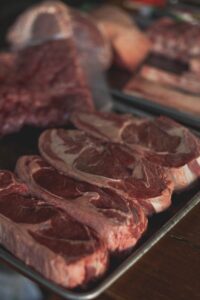
We intentionally package our grass-fed beef (and all our meat for that matter) in meal-sized portions, with clear labels and strong cryovaced wrapping – for freezing.
Freezing our meat is the ideal way to seal in the nutrients and flavour, if you’re not ready to cook and eat it when it’s delivered fresh.
Using the labels on the packets, we want customers to easily see what they have in their freezer so they can use their meat before it’s been frozen too long.
Which leads me to the point of this article about ‘defrosting’. You can ruin delicious meat, even contaminate it with harmful bacteria that may cause sickness, if you defrost it the wrong way.
When it comes to our grass-fed meat here’s our basic guidance:
- Plan ahead. Get in the habit of pulling your meat out of the freezer, allowing enough time to completely thaw your meat in the fridge (either for hours or overnight depending on the size of the cut you’re defrosting) before you plan to cook it.
We can’t stress this enough, frozen meat should be defrosted on the bottom shelf of the refrigerator so it’s kept in safe and hygenic conditions and allowed to increase in temperature at a gradual, constant rate.
Then once it’s fully defrosted, we always recommend taking your meat out of the fridge to bring it to room temperature before you finally cook it.
- If you’ve forgotten to defrost your meat in the fridge and you need to defrost it faster, we suggest immersing your unopened cryovac packaged meat in a bowl or sink of cold water.
Change the water regularly (eg. Every 30 minutes) to increase the temperature of the meat as quickly, but steadily, as possible. This can take 2-3 hours, even longer, depending on the size and cut of meat you’re defrosting.
- Do not thaw meat in hot water.
- Do not leave your meat out on the counter all day.
- Don’t leave your meat at room temperature for more than 2 hours.
- Our least preferred method to defrost meat is using a microwave. Unfortunately microwave defrosting still results in unevenly defrosted meat which can be tough and chewy or even cooked in some parts and still raw in others.
If defrosting using a microwave your meat needs to be cooked immediately. Make sure it doesn’t stand for any length of time at room temperature or in the fridge.
If microwave-defrosting, remove the cryovaced wrapping to prevent your beef from stewing while defrosting and use the pre-programmed ‘defrost’ setting on your microwave.
When defrosting mince in the microwave, remove outer portions of the mince as it thaws and set it aside until the whole portion of mince has been thawed. This can be fiddly but its necessary to encourage even defrosting.
If defrosting roasts or other cuts of meat in the microwave, and the outer surface of the meat feels warm in parts, stop microwaving and allow the beef to stand for a few minutes until the edges are cold again.
Maleny Black Angus Beef is not only 100% grass-fed beef, but we believe it’s the healthiest and tastiest grass-fed Black Angus beef in Australia. With all the nutrition, good fats, flavour and moisture that is inherent in grass-fed beef we want you to enjoy every bite when you eat our meat. That’s why we care so much about how you freeze, defrost and cook it.
Hopefully, the tips in this article will encourage you to ditch the microwave as a means to defrost and get in the habit of taking your meat out of the freezer ahead of time, to allow it to gradually defrost ensuring delicious, juicy meat every time you cook.
Source URL: https://malenyblackangusbeef.com.au/defrosting-meat-dos-donts/

